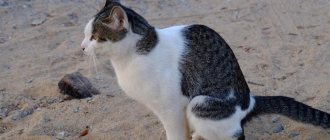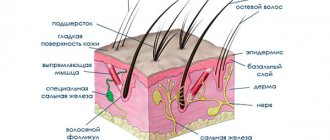Often, hair loss in cats occurs due to psychological problems, infections or parasites. Then the cat itches, does not allow its owners to come near it due to discomfort, and the fur comes out in clumps. Most often, the cat's stomach, area around the eyes and on the neck become bald; the hairs grow unevenly. To restore your pet's health, you must urgently contact a veterinarian. A specialist will help identify the source of the problem and eliminate it.
When is hair loss normal?
Hair loss does not always indicate a cat's health problems. Sometimes this is quite normal. Seasonal shedding is one of the main causes of hair loss in cats. Before summer, the pet's fur coat decreases in volume to avoid overheating in warm weather.
Pregnant and lactating animals lose a lot of hair. The cat's belly and area around the nipples are bald to make it easier for the kittens to suckle. During this period, it is very important to give your pet complete food, including all the necessary vitamins.
It is quite common for older cats to go bald. This is a natural process. If the animal does not show any other symptoms of a possible illness, there is no need to worry.
If an animal wears a collar, hair may fall out in its place. It also happens that hair does not grow back in place of large scars and scars.
Why does a cat have bald spots?
There are many possible reasons why your cat may be losing hair. Some of these may be due to external factors, while others may be a sign that your cat has a medical condition that requires treatment.
Most often, bald spots in cats can be associated with one of the following reasons:
- Fleas or other parasites
- Ringworm
- Stress
- Allergies
- Cancer
© shutterstock
Allergy
A cat can also go bald due to an allergic reaction. A place near the withers or on the muzzle begins to itch, which is why the animal scratches it vigorously, tearing out the hair and scratching it. Without treatment, the cat will constantly scratch its skin until it bleeds, which can lead to blood poisoning or infection.
Quite often, some food component can serve as an allergen. You need to buy hypoallergenic pet food to eliminate this option. If the problem is not solved, you need to look for other possible sources of allergies. It could be plant pollen, household chemicals, flea bites, even dust. Sometimes, if the source of the allergy is not found, injections of hormonal drugs, which are given every few months, can help. It is also important to cover the affected area with a bandage or cloth until your cat's flare-up resolves or responds to treatment.
How to treat the disease?
To quickly cure a cat, you need to know the source of the disease and why the cat’s hair came out. If a cat suffers from baldness due to allergies, then the owner must protect the pet from the irritant. Afterwards, the cat is prescribed histamines, immune system stimulants and hypoallergenic products. If the source is parasites, then bald spots on the tail, back, and legs are treated with ointment against ticks or fleas. In addition, the veterinarian prescribes medications that improve the functioning of the immune system. For endocrine diseases, drugs are used that restore the action of the glands. If alopecia in cats is caused by an abscess, then antiseptics and antibiotics are prescribed.
Baldness of a psychogenic nature is treated with soothing drops on a natural basis.
Stress
Sometimes stress can cause a cat to go bald. If an animal finds itself in a dangerous situation, its home or owner has changed, the fur literally begins to fall off. If the animal has a balanced psyche and good health, then it will quickly adapt to new conditions, and then the problem will disappear. However, if the pet cannot come to its senses for a long time, then sometimes only sedatives can help.
It is better not to touch a cat that is experiencing stress. She must have a place where she can feel safe. You can build a relationship with your new pet through food and toys. You can place your personal item where the cat sleeps so that it quickly gets used to the smell of its new owner.
Where did hairless cats come from?
You will experience the first shock when you first look at the Sphinx. You will not remain indifferent! The second shock is the feeling of a hot body in your hands. Whoever picks up the sphinx even once will never let it go.
What do we know about these amazing cats?
The first historical mentions of hairless cats date back to the times of the Aztecs. More recent information about them was found in India and Morocco, as well as in Paraguay. In the 60s of the 20th century, the first hairless cats were bred in Canada through the joint efforts of Canadian and French felinologists. The breed was named "Canadian Sphynx".
Canadian Sphynx Photo: George Balatsos, ru.wikipedia.org
In Toronto, a hairless kitten was born among the kittens of an ordinary domestic cat. Subsequently, he was crossed with his own mother - and again the litter ended up with hairless kittens. Some time later, in 1975, in the USA, the situation repeated itself: a hairless kitten was born from a simple cat, not without humor called Epidermis.
So gradually, by crossing rare representatives of these individuals, the number of sphinxes grew, and the result was not slow to show: today the Canadian Sphynx breed is one of the most popular. Canadian Sphynxes are not always completely hairless: they may have residual hairs on the muzzle, ears and tip of the tail, although there are also completely hairless specimens. But they don’t have whiskers—an essential cat attribute!
“Canadians” are quite muscular, strong, they have a wide and well-developed chest, slender but strong legs and a muscular neck. The ears are very large and widely spaced.
Despite the lack of hair, the Canadian Sphynx is a strong, resilient breed. The first representative of this breed lived 28 years! By nature, Sphynx cats are friendly, affectionate, sociable cats that need contact with their owners.
Photo: Depositphotos
But the Canadian Sphynx is not the only representative of hairless cats. In 1987, Elena Kovaleva, a resident of Rostov-on-Don, found a kitten on the street that had practically no hair. The fluff was only on the paws, tail, behind the ears and on the chest. Elena mistook the hungry abandoned kitten for a sick one, took pity on him and took him home. The cat was named Varvara, and a few years later she gave birth to kittens from an ordinary cat, Vasily. What is most surprising is that among the kittens there were also “naked” specimens.
It became clear that this was not Varvara’s defect, but a stable genetic mutation. Most likely, this mutation arose under the influence of environmental factors and was inherited by the kittens.
Since the ancestors of the foundling are unknown, the cat Varvara can rightfully be considered the progenitor of the “tribe” of hairless cats in Russia. As a result of the persistent and painstaking work of Russian felinologists for many years, by 1998 a new unique breed was approved - the “Don Sphynx”.
Despite the fact that this breed was officially recognized only in 1998, “Donchak” people have been involved in crossing and breeding new breeds of cats since the early 90s.
So, in 1994, Radmoy Von Jagerhoff's cat of the oriental breed gave birth to kittens from the Don Sphynx Afinogenes Mifa. For further selection work, four kittens were selected from the first two litters: Mandarin from Murino, Muscat from Murino, Nezhenka from Murino and Nocturne from Murino. These kittens became representatives of a new breed - the “Petersburg Sphynx”, or “Peterbald”.
In 1996, the breed was registered with the Breeding Felinological Federation. The Peterbald is a representative of the Siamese-Oriental group of cats and differs from the Don Sphynx in its more fragile and graceful physique.
One of the most attractive features of the Peterbald breed is its lack of aggressiveness and rancor towards humans or other pets. Peterbalds are very affectionate animals, even when dealing with infants.
Why were these cats called Peterbalds? The name of the breed comes from the English “peterbald” and means “bald Peter”. This word arose under the impression that the sculpture of Peter the Great resting in the Peter and Paul Fortress made on the creator of this breed, Olga Sergeevna Mironova.
Photo: Depositphotos
The Don and St. Petersburg sphinxes have long received international recognition and, along with the Canadian sphinxes, participate in exhibitions around the world. It is impossible to answer the question which breed is better. Sphynx cats don't need to be compared to other cats, you just need to love them!
Tags: Sphynx, hairless cats, cat breed, Peterbald, Don Sphynx, Canadian Sphynx, domestic cat, breed features, pets
Lichen
Ringworm is a fungal disease that is also dangerous for humans. First of all, it affects weakened and sick animals, and is very common in street cats. With lichen, the head, neck and limbs go bald. Scabs form on bald areas of the skin. If the animal is not treated, lichen can affect the entire body. At the same time, the cat does not itch, and therefore it is possible to notice lichen in time only by periodically examining the skin of the animal.
Only a veterinarian can accurately determine lichen by scraping or illuminating the affected area with a special lamp. Even after treatment, the affected areas of skin may remain bald.
Fleas and ticks
When infected with skin parasites, the animal initially begins to itch severely and feel anxious. Over time, some areas of his skin may begin to go bald. Fleas can cause not only baldness in a cat, but also anemia. It is not so difficult to remove them: you can wash the cat with a special shampoo, drop medicine on the withers, or treat it with a special product. There is no need to ignore this problem, because flea infestation can lead to very unpleasant consequences.
A cat's ears can go bald if ear mites are in an advanced form. Ear mites cause severe itching. Dark dirt forms inside the ears - these are waste products of mites. To remove ticks, you need to regularly clean the animal's ears using cotton swabs and hydrogen peroxide.
A cat becomes bald at the tail, in the area of the ears and eyes, on the bridge of the nose and paw pads if infected with subcutaneous mites. This tick is also contagious to humans. To get rid of it, drug treatment is necessary.
Ticks cause discomfort to the cat, causing severe itching, but they can also lead to the animal becoming infected with dangerous infections. Some species are also dangerous to humans. To prescribe effective treatment, the animal must be shown to a doctor.
Adenitis
Most often, adenitis is observed in males. This is a hereditary disease that manifests itself in adolescence or old age. As a result, small crusts form on the ears and head. The fur in these places can be easily pulled out of the skin, and the animal will not even feel it. The affected areas are round in shape and sometimes have an unpleasant odor. If the disease is not cured in time, it spreads to the back and to the base of the tail.
Adenitis appears due to improper functioning of the sebaceous glands. Only a doctor can diagnose it and prescribe treatment after examining a skin scraping.
When is baldness a sign of pathology?
Hair loss occurs in all members of the cat family that have fur on their bodies. The exception is animals that, due to their breed characteristics, have a “naked” body. Your pet may lose fur:
- during the molting season (up to twice a year);
- due to age-related changes (in older individuals, in addition to body hair, mustaches also fall out);
- during pregnancy and lactation (due to hormonal fluctuations, lack of vitamins in the body);
- from frequent water procedures (it is enough to wash the cat once every six months).
In the above cases, the hair falls out en masse, but evenly. Pathological baldness (alopecia - in scientific terms) can be recognized by several signs:
- The fur falls out in clumps, forming bald spots. Bare parts of the body can be found behind the ears, above the eyes, on the back, neck, and at the root of the tail.
- Places “freed” from fur acquire a pink tint or turn red.
- Weeping ulcers and scabs may occur.
- The naked body hurts and itches. The cat reacts especially sharply when touching bald patches.
Places where hair falls out in clumps can be centralized (foci on a certain area of the body) or generalized (massive baldness over a large surface of the body).
Folliculitis
This is an infectious disease that affects the hair follicles, which is accompanied by baldness of the cat. This disease causes severe itching in the animal. The cat's face and neck become bald, pustules appear, the fur sticks together and rolls down. The cat's activity decreases and body temperature rises. Without proper treatment, the disease moves to the stomach, back and base of the tail.
To diagnose folliculitis, you need to do a skin scraping and biopsy. For treatment, the hair from the affected areas is cut off, the pustules are opened, and the skin is treated with ointment. The animal is given antibiotics.
Manifestations and symptoms
To understand the cause of baldness, it is necessary to establish with what intensity this phenomenon is progressing and what accompanying symptoms appear in the animal.
The main signs are:
- uniform thinning of coat throughout the body;
- bald spots on the stomach, face, paws, ears, at the base of the tail or throughout the tail;
- redness and peeling of the affected areas;
- itching;
- signs of anxiety (constant licking of sore areas, nervous tail wagging, etc.);
- ulcers, ulcers, bumps or blisters on bald spots.
Recognizing these symptoms requires immediate attention to your veterinarian, as hair loss can quickly worsen.
Treatment and prevention
If you find that your cat is going bald, what should you do first? First you need to accurately determine the cause. Many diseases directly affect the condition of the coat, so help can only be made with a correct diagnosis.
If your cat's hair begins to fall out, it should be taken to the vet immediately. The doctor will examine the animal and take all the necessary tests. And then he will prescribe treatment, which must be strictly adhered to.
Judging by reviews from breeders, animals that eat properly are least susceptible to the disease. Natural or ready-made dry food must be properly balanced and contain all the necessary vitamins and minerals. Among ready-made feeds, preference should be given to premium and super-premium types.
Do not forget about the importance of vaccinations, which cats are given in childhood and then repeated every year. Even an animal that is deprived of access to the street must be vaccinated, since it can become infected through the owner’s street clothes or shoes. Periodically, the cat needs to be treated for fleas and given anthelmintic drugs. You need to take good care of the animal and check its fur once a month for bald patches or wounds.
Thus, it can sometimes be difficult to determine why a cat is going bald. It is important to contact a specialist in time and undergo all necessary tests. It must be remembered that some diseases can not only be fatal to the animal itself, but also contagious to its owner.
Contacting a veterinarian
Alopecia cannot be ignored; immediately take your pet to a veterinary clinic. Only a veterinarian can determine the cause of baldness. Self-medication of a cat is prohibited. The owner may give the wrong medications, which will worsen baldness and weaken the body.
Diagnostic procedures and tests
To find out why a cat is going bald, the veterinarian prescribes laboratory and instrumental tests.
| procedure | why is it carried out? |
| blood analysis | determining the state of the body, identifying inflammation and hormonal imbalance |
| radiography | studying the condition of internal organs, identifying malignant tumors |
| Ultrasound | |
| microscopic examination of wool | detection of external parasites |
| skin scraping | |
| black wood lamp |
Memo for the owner
When you bring your pet in for an appointment, your veterinarian will begin by taking a history. You need to tell in as much detail as possible about the cat’s diet, living conditions, and heredity. You cannot withhold information: this will complicate the diagnosis. Don’t lie if you feed your cat poor quality food and allow your child to abuse him.
If you tried to treat your pet for baldness on your own, tell us about it. Remember what medications were used and how the cat’s body reacted.
It is not difficult to prevent pathological baldness of a cat, you just need to remain a caring owner:
- buy quality food, maintain a balanced diet;
- do not provoke stress;
- promptly vaccinate against infections and carry out antiparasitic treatment;
- regularly take your cat for preventive examinations;
- do not allow your pet to come into contact with homeless relatives.
Remember, a quiet life and good nutrition are the main factors for the health of a cat’s coat. React to the slightest changes in the animal's condition. Timely and competent treatment prescribed by a veterinarian will protect your pet from complications and stress.











